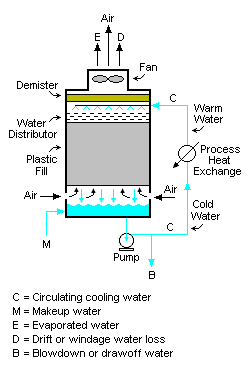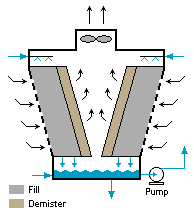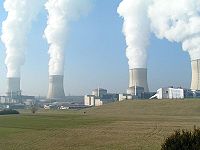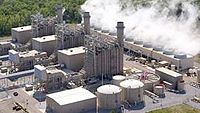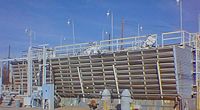User:Milton Beychok/Sandbox: Difference between revisions
imported>Milton Beychok mNo edit summary |
imported>Milton Beychok No edit summary |
||
| Line 20: | Line 20: | ||
If that same plant had no cooling tower and used once-through cooling water, it would require about 100,000 cubic metres an hour <ref>{{PDFlink|[http://204.154.137.14/technologies/coalpower/ewr/pubs/IEP_Power_Plant_Water_R&D_Final_1.pdf Department of Energy]|297 [[Kibibyte|KiB]]<!-- application/pdf, 304538 bytes -->}} Office of Fossil Energy's Power Plant Water Management R&D Program</ref> and that amount of water would have to be continuously returned to the ocean, lake or river from which it was obtained and continuously re-supplied to the plant. Furthermore, discharging large amounts of hot water may raise the temperature of the receiving river or lake to an unacceptable level for the local ecosystem. A cooling tower serves to dissipate the heat into the atmosphere instead and wind and air diffusion spreads the heat over a much larger area than hot water can distribute heat in a body of water. | If that same plant had no cooling tower and used once-through cooling water, it would require about 100,000 cubic metres an hour <ref>{{PDFlink|[http://204.154.137.14/technologies/coalpower/ewr/pubs/IEP_Power_Plant_Water_R&D_Final_1.pdf Department of Energy]|297 [[Kibibyte|KiB]]<!-- application/pdf, 304538 bytes -->}} Office of Fossil Energy's Power Plant Water Management R&D Program</ref> and that amount of water would have to be continuously returned to the ocean, lake or river from which it was obtained and continuously re-supplied to the plant. Furthermore, discharging large amounts of hot water may raise the temperature of the receiving river or lake to an unacceptable level for the local ecosystem. A cooling tower serves to dissipate the heat into the atmosphere instead and wind and air diffusion spreads the heat over a much larger area than hot water can distribute heat in a body of water. | ||
Some coal-fired and nuclear power plants located in coastal areas do make use of once-through ocean water. But even there, the offshore discharge water outlet requires very careful design to avoid environmental problems. | Some coal-fired and nuclear power plants located in coastal areas do make use of once-through ocean water. But even there, the offshore discharge water outlet requires very careful design to avoid environmental problems. | ||
| Line 28: | Line 28: | ||
==Heat transfer methods== | ==Heat transfer methods== | ||
With respect to the [[heat transfer]] mechanism employed, the main types are: | With respect to the [[heat transfer]] mechanism employed, the main types are: | ||
* ''Wet cooling towers'' or simply ''cooling towers'' operate on the principle of [[Evaporative cooling|evaporation]]. | * ''Wet cooling towers'' or simply ''cooling towers'' operate on the principle of [[Evaporative cooling|evaporation]]. | ||
| Line 45: | Line 45: | ||
** ''Induced draft'': A mechanical draft tower with a fan at the discharge which pulls air through tower. The fan ''induces'' hot moist air out the discharge. This produces low entering and high exiting air velocities, reducing the possibility of ''recirculation'' in which discharged air flows back into the air intake. This fan/fill arrangement is also known as ''draw-through''. (see Image 2, 3) | ** ''Induced draft'': A mechanical draft tower with a fan at the discharge which pulls air through tower. The fan ''induces'' hot moist air out the discharge. This produces low entering and high exiting air velocities, reducing the possibility of ''recirculation'' in which discharged air flows back into the air intake. This fan/fill arrangement is also known as ''draw-through''. (see Image 2, 3) | ||
** ''Forced draft'': A mechanical draft tower with a blower type fan at the intake. The fan ''forces'' air into the tower, creating high entering and low exiting air velocities. The low exiting velocity is much more susceptible to recirculation. With the fan on the air intake, the fan is more susceptible to complications due to freezing conditions. Another disadvantage is that a forced draft design typically requires more motor horsepower than an equivalent induced draft design. The forced draft benefit is its ability to work with high static pressure. They can be installed in more confined spaces and even in some indoor situations. This fan/fill geometry is also known as ''blow-through''. (see Image 4) | ** ''Forced draft'': A mechanical draft tower with a blower type fan at the intake. The fan ''forces'' air into the tower, creating high entering and low exiting air velocities. The low exiting velocity is much more susceptible to recirculation. With the fan on the air intake, the fan is more susceptible to complications due to freezing conditions. Another disadvantage is that a forced draft design typically requires more motor horsepower than an equivalent induced draft design. The forced draft benefit is its ability to work with high static pressure. They can be installed in more confined spaces and even in some indoor situations. This fan/fill geometry is also known as ''blow-through''. (see Image 4) | ||
* Fan assisted natural draft. A hybrid type that appears like a natural draft though airflow is assisted by a fan. | * Fan assisted natural draft. A hybrid type that appears like a natural draft though airflow is assisted by a fan. | ||
| Line 56: | Line 55: | ||
Crossflow is a design in which the air flow is directed perpendicular to the water flow (see diagram below). Air flow enters one or more vertical faces of the cooling tower to meet the fill material. Water flows (perpendicular to the air) through the fill by gravity. The air continues through the fill and thus past the water flow into an open plenum area. A ''distribution'' or ''hot water basin'' consisting of a deep pan with holes or ''nozzles'' in the bottom is utilized in a crossflow tower. Gravity distributes the water through the nozzles uniformly across the fill material. | Crossflow is a design in which the air flow is directed perpendicular to the water flow (see diagram below). Air flow enters one or more vertical faces of the cooling tower to meet the fill material. Water flows (perpendicular to the air) through the fill by gravity. The air continues through the fill and thus past the water flow into an open plenum area. A ''distribution'' or ''hot water basin'' consisting of a deep pan with holes or ''nozzles'' in the bottom is utilized in a crossflow tower. Gravity distributes the water through the nozzles uniformly across the fill material. | ||
===Counterflow=== | ===Counterflow=== | ||
| Line 62: | Line 61: | ||
open area beneath the fill media and is then drawn up vertically. The water is sprayed through pressurized nozzles and flows downward through the fill, opposite to the air flow. | open area beneath the fill media and is then drawn up vertically. The water is sprayed through pressurized nozzles and flows downward through the fill, opposite to the air flow. | ||
Common to both designs: | Common to both designs: | ||
| Line 79: | Line 78: | ||
Quantitatively, the material balance around a wet, evaporative cooling tower system is governed by the operational variables of makeup [[flow rate]], [[evaporation]] and windage losses, draw-off rate, and the concentration cycles:<ref name=Beychok>{{cite book | author=Beychok, Milton R. | title=[[Aqueous Wastes from Petroleum and Petrochemical Plants]] |edition=1st Edition | publisher=John Wiley and Sons | year=1967|id=[[Library of Congress Control Number|LCCN 67019834]]}} (available in many university libraries)</ref> | Quantitatively, the material balance around a wet, evaporative cooling tower system is governed by the operational variables of makeup [[flow rate]], [[evaporation]] and windage losses, draw-off rate, and the concentration cycles:<ref name=Beychok>{{cite book | author=Beychok, Milton R. | title=[[Aqueous Wastes from Petroleum and Petrochemical Plants]] |edition=1st Edition | publisher=John Wiley and Sons | year=1967|id=[[Library of Congress Control Number|LCCN 67019834]]}} (available in many university libraries)</ref> | ||
{| border="0" cellpadding="2" | {| border="0" cellpadding="2" | ||
| Line 165: | Line 164: | ||
Ambient conditions dictate the efficiency of any given tower due to the amount of water vapor the air is able to absorb and hold, as can be determined on a psychrometric chart. | Ambient conditions dictate the efficiency of any given tower due to the amount of water vapor the air is able to absorb and hold, as can be determined on a psychrometric chart. | ||
==Cooling tower malfunctions== | ==Cooling tower malfunctions== | ||
Revision as of 18:51, 4 March 2008
Industrial cooling towers are heat rejection devices used primarily to supply circulating cooling water to industrial facilities. The circulating cooling water absorbs heat by cooling and/or condensing hot process streams within the industrial facilites and the cooling towers reject that absorbed heat to the atmosphere.
Cooling towers may either use the evaporation of water to reject process heat and cool the circulating water to near the wet-bulb air temperature or rely solely on air to cool the circulating cooling water to near the dry-bulb air temperature. The towers may be hyperboloid structures (as in Image 1) that can be up to 200 metres tall and 100 metres in diameter, or rectangular structures (as in Image 2) that can be over 40 metres tall and 80 metres long.
Applications
Common applications include cooling the circulating water used in oil refineries, chemical plants, power plants and building cooling.
The primary use of large, industrial cooling towers is to remove the heat absorbed in the circulating cooling water systems used in power plants, petroleum refineries, petrochemical plants, natural gas processing plants, food processing plants, semi-conductor plants, and other industrial facilities. The circulation rate of cooling water in a typical 700 MW coal-fired power plant with a cooling tower amounts to about 71,600 cubic metres an hour (315,000 U.S. gallons per minute)[1] and the circulating water requires a supply water make-up rate of perhaps 5 percent (i.e., 3,600 cubic metres an hour).
If that same plant had no cooling tower and used once-through cooling water, it would require about 100,000 cubic metres an hour [2] and that amount of water would have to be continuously returned to the ocean, lake or river from which it was obtained and continuously re-supplied to the plant. Furthermore, discharging large amounts of hot water may raise the temperature of the receiving river or lake to an unacceptable level for the local ecosystem. A cooling tower serves to dissipate the heat into the atmosphere instead and wind and air diffusion spreads the heat over a much larger area than hot water can distribute heat in a body of water.
Some coal-fired and nuclear power plants located in coastal areas do make use of once-through ocean water. But even there, the offshore discharge water outlet requires very careful design to avoid environmental problems.
Petroleum refineries also have very large cooling tower systems. A typical large refinery processing 40,000 metric tonnes of crude oil per day (300,000 barrels per day) circulates about 80,000 cubic metres of water per hour through its cooling tower system.
The world's tallest cooling tower is the 200 metre tall cooling tower of Niederaussem Power Station.
Heat transfer methods
With respect to the heat transfer mechanism employed, the main types are:
- Wet cooling towers or simply cooling towers operate on the principle of evaporation.
- Dry coolers operate by heat transmission through a surface that divides the working fluid from ambient air. They thus rely mainly on convection heat transfer to reject heat from the working fluid, rather than evaporation.
- Fluid coolers are hybrids that pass the working fluid through a tube bundle, upon which clean water is sprayed and a fan-induced draft applied. The resulting heat transfer performance is much closer to that of a wet cooling tower, with the advantage provided by a dry cooler of protecting the working fluid from environmental exposure.
In a wet cooling tower, the warm water can be cooled to a temperature lower than the ambient air dry-bulb temperature, if the air is relatively dry. (see: dew point and psychrometrics). As air is drawn past a flow of water, the two flows attempt to equalize. The air, if not saturated, absorbs additional water vapor, leaving less heat in the remaining water flow.
To achieve better performance (more cooling), a media called fill is used to increase the surface area between the air and water flows. Splash fill consists of material placed to interrupt the water flow causing splashing. Film fill is composed of thin sheets of material upon which the water flows. Both methods create increased surface area.
Air flow generation methods
With respect to drawing air through the tower, there are three types of cooling towers:
- Natural draft, which utilizes buoyancy via a tall chimney. Warm, moist air naturally rises due to the density differential to the dry, cooler outside air. Warm moist air is less dense than drier air at the same temperature and pressure. This moist air buoyancy produces a current of air through the tower.
- Mechanical draft, which uses power driven fan motors to force or draw air through the tower.
- Induced draft: A mechanical draft tower with a fan at the discharge which pulls air through tower. The fan induces hot moist air out the discharge. This produces low entering and high exiting air velocities, reducing the possibility of recirculation in which discharged air flows back into the air intake. This fan/fill arrangement is also known as draw-through. (see Image 2, 3)
- Forced draft: A mechanical draft tower with a blower type fan at the intake. The fan forces air into the tower, creating high entering and low exiting air velocities. The low exiting velocity is much more susceptible to recirculation. With the fan on the air intake, the fan is more susceptible to complications due to freezing conditions. Another disadvantage is that a forced draft design typically requires more motor horsepower than an equivalent induced draft design. The forced draft benefit is its ability to work with high static pressure. They can be installed in more confined spaces and even in some indoor situations. This fan/fill geometry is also known as blow-through. (see Image 4)
- Fan assisted natural draft. A hybrid type that appears like a natural draft though airflow is assisted by a fan.
Hyperboloid (aka hyperbolic) cooling towers (Image 1) have become the design standard for all natural-draft cooling towers because of their structural strength and minimum usage of material. The hyperbolic form is popularly associated with nuclear power plants. However, this association is misleading, as the same kind of cooling towers are often used at large coal-fired power plants as well. Similarly, not all nuclear power plants have cooling towers.
Categorization by air-to-water flow
Crossflow
Crossflow is a design in which the air flow is directed perpendicular to the water flow (see diagram below). Air flow enters one or more vertical faces of the cooling tower to meet the fill material. Water flows (perpendicular to the air) through the fill by gravity. The air continues through the fill and thus past the water flow into an open plenum area. A distribution or hot water basin consisting of a deep pan with holes or nozzles in the bottom is utilized in a crossflow tower. Gravity distributes the water through the nozzles uniformly across the fill material.
Counterflow
In a counterflow design the air flow is directly opposite of the water flow (see diagram below). Air flow first enters an open area beneath the fill media and is then drawn up vertically. The water is sprayed through pressurized nozzles and flows downward through the fill, opposite to the air flow.
Common to both designs:
- The interaction of the air and water flow allow a partial equalization and evaporation of water.
- The air, now saturated with water vapor, is discharged from the cooling tower.
- A collection or cold water basin is used to contain the water after its interaction with the air flow.
Both crossflow and counterflow designs can be used in natural draft and mechanical draft cooling towers.
Cooling tower as a flue gas stack
At some modern power stations, equipped with flue gas purification like the Power Station Staudinger Grosskrotzenburg and the Power Station Rostock, the cooling tower is also used as a flue gas stack (industrial chimney). At plants without flue gas purification, this causes problems with corrosion.
Wet cooling tower material balance
Quantitatively, the material balance around a wet, evaporative cooling tower system is governed by the operational variables of makeup flow rate, evaporation and windage losses, draw-off rate, and the concentration cycles:[3]
| M | = Make-up water in m³/hr |
| C | = Circulating water in m³/hr |
| D | = Draw-off water in m³/hr |
| E | = Evaporated water in m³/hr |
| W | = Windage loss of water in m³/hr |
| X | = Concentration in ppmw (of any completely soluble salts … usually chlorides) |
| XM | = Concentration of chlorides in make-up water (M), in ppmw |
| XC | = Concentration of chlorides in circulating water (C), in ppmw |
| Cycles | = Cycles of concentration = XC / XM (dimensionless) |
| ppmw | = parts per million by weight |
In the above sketch, water pumped from the tower basin is the cooling water routed through the process coolers and condensers in an industrial facility. The cool water absorbs heat from the hot process streams which need to be cooled or condensed, and the absorbed heat warms the circulating water (C). The warm water returns to the top of the cooling tower and trickles downward over the fill material inside the tower. As it trickles down, it contacts ambient air rising up through the tower either by natural draft or by forced draft using large fans in the tower. That contact causes a small amount of the water to be lost as windage (W) and some of the water (E) to evaporate. The heat required to evaporate the water is derived from the water itself, which cools the water back to the original basin water temperature and the water is then ready to recirculate. The evaporated water leaves its dissolved salts behind in the bulk of the water which has not been evaporated, thus raising the salt concentration in the circulating cooling water. To prevent the salt concentration of the water from becoming too high, a portion of the water is drawn off (D) for disposal. Fresh water makeup (M) is supplied to the tower basin to compensate for the loss of evaporated water, the windage loss water and the draw-off water.
A water balance around the entire system is:
- M = E + D + W
Since the evaporated water (E) has no salts, a chloride balance around the system is:
- M (XM) = D (XC) + W (XC) = XC (D + W)
and, therefore:
- XC / XM = Cycles of concentration = M ÷ (D + W) = M ÷ (M – E) = 1 + [E ÷ (D + W)]
From a simplified heat balance around the cooling tower:
- E = C · ΔT · cp ÷ HV
| where: | |
| HV | = latent heat of vaporization of water = ca. 2260 kJ / kg |
| ΔT | = water temperature difference from tower top to tower bottom, in °C |
| cp | = specific heat of water = ca. 4.184 kJ / (kg°C) |
Windage (or drift) losses (W) from large-scale industrial cooling towers, in the absence of manufacturer's data, may be assumed to be:
- W = 0.3 to 1.0 percent of C for a natural draft cooling tower without windage drift eliminators
- W = 0.1 to 0.3 percent of C for an induced draft cooling tower without windage drift eliminators
- W = about 0.005 percent of C (or less) if the cooling tower has windage drift eliminators
Cycles of concentration represents the accumulation of dissolved minerals in the recirculating cooling water. Draw-off (or blowdown) is used principally to control the buildup of these minerals.
The chemistry of the makeup water including the amount of dissolved minerals can vary widely. Makeup waters low in dissolved minerals such as those from surface water supplies (lakes, rivers etc.) tend to be aggressive to metals (corrosive). Makeup waters from ground water supplies (wells) are usually higher in minerals and tend to be scaling (deposit minerals). Increasing the amount of minerals present in the water by cycling can make water less aggressive to piping however excessive levels of minerals can cause scaling problems.
As the cycles of concentration increase the water may not be able to hold the minerals in solution. When the solubility of these minerals have been exceeded they can precipitate out as mineral solids and cause fouling and heat exchange problems in the cooling tower or the heat exchangers. The temperatures of the recirculating water, piping and heat exchange surfaces determine if and where minerals will precipitate from the recirculating water. Often a professional water treatment consultant will evaluate the makeup water and the operating conditions of the cooling tower and recommend an appropriate range for the cycles of concentration. The use of water treatment chemicals, pretreatment such as water softening, pH adjustment, and other techniques can affect the acceptable range of cycles of concentration.
Concentration cycles in the majority of cooling towers usually range from 3 to 7. In the United States the majority of water supplies are well waters and have significant levels of dissolved solids. On the other hand one of the largest water supplies, New York City, has a surface supply quite low in minerals and cooling towers in that city are often allowed to concentrate to 7 or more cycles of concentration.
Besides treating the circulating cooling water in large industrial cooling tower systems to minimize scaling and fouling, the water should be filtered and also be dosed with biocides and algaecides to prevent growths that could interfere with the continuous flow of the water.[3] For closed loop evaporative towers, corrosion inhibitors may be used, but caution should be taken to meet local environmental regulations as some inhibitors use chromates.
Ambient conditions dictate the efficiency of any given tower due to the amount of water vapor the air is able to absorb and hold, as can be determined on a psychrometric chart.
Cooling tower malfunctions
Under certain ambient conditions, plumes of water vapor (fog) can be seen rising out of the discharge from a cooling tower (see Image 1), and can be mistaken as smoke from a fire. If the outdoor air is at or near saturation, and the tower adds more water to the air, saturated air with liquid water droplets can be discharged -- what we see as fog. This phenomenon typically occurs on cool, humid days, but is rare in many climates.
Failures that let smaller amounts of water go the top of a cooling tower can cause a tower to freeze (especially if the fans are running at high speeds). If a roof-mounted cooling tower is allowed to freeze and build up ice, the ice can grow to massive sizes and can result in the tower falling through the roof (note: this assumes that the ice 'grows' beyond the typical liquid volume).
Typical methods to circumvent freezing are: air flow through the tower is reduced, a basin heater is installed, a heater is installed indoors on the water loop, a drain system or remote basin design is used, and in some cases where evaporative closed loop towers are used the tower spray water is drained completely.
Cooling Tower Operation In Freezing Weather
Cooling towers with malfunctions can freeze during very cold weather. Typically, freezing starts at the corners of a cooling tower with a reduced or absent heat load. Increased freezing conditions can create growing volumes of ice, resulting in increased structural loads. During the winter, some sites continuously operate cooling towers with 40 °F water leaving the tower. Basin heaters, tower draindown, and other freeze protection methods are often employed in cold climates.
- Do not operate the tower unattended.
- Do not operate the tower without a heat load. This can include basin heaters and heat trace. Basin heaters maintain the temperature of the water in the tower pan at an acceptable level. Heat trace is a resistive element that runs along water pipes located in cold climates to prevent freezing.
- Maintain design water flow rate over the fill.
- Manipulate airflow to maintain water temperature above freezing point.[4]
Some commonly used terms in the cooling tower industry
- Drift - Water droplets that are carried out of the cooling tower with the exhaust air. Drift droplets have the same concentration of impurities as the water entering the tower. The drift rate is typically reduced by employing baffle-like devices, called drift eliminators, through which the air must travel after leaving the fill and spray zones of the tower.
- Blow-out - Water droplets blown out of the cooling tower by wind, generally at the air inlet openings. Water may also be lost, in the absence of wind, through splashing or misting. Devices such as wind screens, louvers, splash deflectors and water diverters are used to limit these losses.
- Plume - The stream of saturated exhaust air leaving the cooling tower. The plume is visible when water vapor it contains condenses in contact with cooler ambient air, like the saturated air in one's breath fogs on a cold day. Under certain conditions, a cooling tower plume may present fogging or icing hazards to its surroundings. Note that the water evaporated in the cooling process is "pure" water, in contrast to the very small percentage of drift droplets or water blown out of the air inlets.
- Blow-down - The portion of the circulating water flow that is removed in order to maintain the amount of dissolved solids and other impurities at an acceptable level. It may be noted that higher TDS (total dissolved solids) concentration in solution results in greater potential cooling tower efficiency. However the higher the TDS concentration, the greater the risk of scale, biological growth and corrosion.
- Leaching - The loss of wood preservative chemicals by the washing action of the water flowing through a wood structure cooling tower.
- Noise - Sound energy emitted by a cooling tower and heard (recorded) at a given distance and direction. The sound is generated by the impact of falling water, by the movement of air by fans, the fan blades moving in the structure, and the motors, gearboxes or drive belts.
- Approach - The approach is the difference in temperature between the cooled-water temperature and the entering-air wet bulb temperature (twb). Since the cooling towers are based on the principles of evaporative cooling, the maximum cooling tower efficiency depends on the wet bulb temperature of the air.
- Range - The range is the temperature difference between the water inlet and water exit.
- Fill - Inside the tower, fills are added to increase contact surface as well as contact time between air and water. Thus they provide better heat transfer. The efficiency of the tower also depends on them. There are two types of fills that may be used:
- Film type fill (causes water to spread into a thin film)
- Splash type fill (breaks up water and interrupts its vertical progress)
Fire hazards
Cooling towers which are constructed in whole or in part of combustible materials can support propagating internal fires. The resulting damage can be sufficiently severe to require the replacement of the entire cell or tower structure. For this reason, some codes and standards[5] recommend combustible cooling towers be provided with an automatic fire sprinkler system. Fires can propagate internally within the tower structure during maintenance when the cell is not in operation (such as for maintenance or construction), and even when the tower is in operation, especially those of the induced-draft type because of the existence of relatively dry areas within the towers[6].
References
- ↑ Cooling System Retrofit Costs EPA Workshop on Cooling Water Intake Technologies, John Maulbetsch, Maulbetsch Consulting, May 2003
- ↑ Template:PDFlink Office of Fossil Energy's Power Plant Water Management R&D Program
- ↑ 3.0 3.1 Beychok, Milton R. (1967). Aqueous Wastes from Petroleum and Petrochemical Plants, 1st Edition. John Wiley and Sons. LCCN 67019834. (available in many university libraries)
- ↑ Template:PDFlink
- ↑ NFPA 214, Standard for Water Cooling Towers
- ↑ NFPA 214, Standard for Water Cooling Towers, section A1.1
